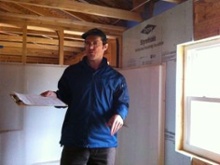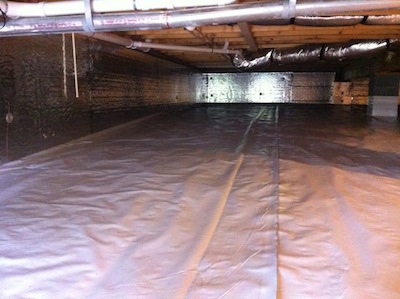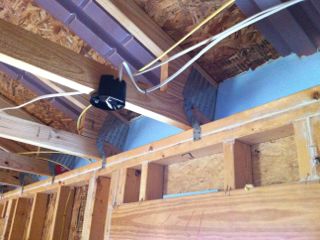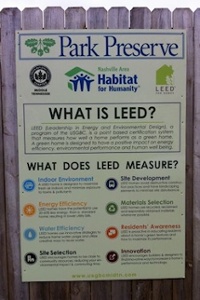Habitat for Humanity Leads the Way to Affordable, Green Homes

 Habitat for Humanity is showing that affordable housing and high-performance homes isn’t an either/or choice. They’ve been doing great work and going in this direction for a long time, but in the past 5 years, they’ve really stepped it up a notch. Their mission statement includes the following statement on sustainability:
Habitat for Humanity is showing that affordable housing and high-performance homes isn’t an either/or choice. They’ve been doing great work and going in this direction for a long time, but in the past 5 years, they’ve really stepped it up a notch. Their mission statement includes the following statement on sustainability:
Habitat for Humanity is showing that affordable housing and high-performance homes isn’t an either/or choice. They’ve been doing great work and going in this direction for a long time, but in the past 5 years, they’ve really stepped it up a notch. Their mission statement includes the following statement on sustainability:
Support sustainable and transformational development.
We view our work as successful when it transforms lives and promotes positive and lasting social, economic and spiritual change within a community; when it is based on mutual trust and fully shared accomplishment; and when it demonstrates responsible stewardship of all resources entrusted to us.
It’s the people!
 Kevin Gobble is a Sustainable Building and Design Specialist, and he’s one of the many people in the organization pushing Habitat to make their homes better. A few years ago, they decided that all their homes (at least in the US) would be built to ENERGY STAR new home standards and get the ENERGY STAR label. Not all of the affiliates have gotten on board with that, but plenty have.
Kevin Gobble is a Sustainable Building and Design Specialist, and he’s one of the many people in the organization pushing Habitat to make their homes better. A few years ago, they decided that all their homes (at least in the US) would be built to ENERGY STAR new home standards and get the ENERGY STAR label. Not all of the affiliates have gotten on board with that, but plenty have.
In addition to Kevin, who works out of the Atlanta headquarters, I’ve met many other Habitat folks from around the country who are smart and dedicated and making sure that Habitat’s homes are indeed affordable, high-performance homes. A few that stand out are Tiffani Irwin and Rob Howard in NC, Ed Brown in Seattle, and Andy Bell in Alabama. Then there are all the certified home energy raters who work to get the homes rated and certified. Energy Vanguard’s own Jeffrey Sauls has put in a lot of volunteering (and even won an award for it), as have many of the raters that we work with as their HERS provider.
Habitat’s rocking in NC
Last week, I was doing quality assurance on our raters in Boone, North Carolina and got to visit a Habitat community in Mt. Airy, NC. (Yes, that Mt. Airy, the one also known as Mayberry, home of Andy, Opie, Aunt Bee, Barnie Fife, and Floyd the barber.) The photo at top is Scott Suddreth of Building Performance Engineering telling me about some of the features in this house. Notice the sheathing behind the bathtub. Many homes don’t have that, but it’s required by ENERGY STAR and Advanced Energy’s System Vision program, which Habitat in NC also participates in.

The three houses being built there are truly high-performance homes. Greg Russo, the builder and a fellow Louisianan (though I grew up way down the bayou from him), really gets it and is doing a fantastic job with the homes he’s building. Here are few other nice things I saw while I was there:
- Beautifully encapsulated crawl space (shown above)
- Bath fans with straight, insulated duct (not nearly as common as it should be)
- Air handler and duct system inside the building envelope
- Insulated headers
- Nicely installed soffit vent baffles and insulation dams (shown below)

I love visiting Habitat homes because overall, they’re doing such a great job, and in some places, like these homes in Mt. Airy, NC, the work is stellar. They didn’t get everything right—almost no one does—but it’s wonderful to see the attention to detail I saw last week in these homes. With an organization like Building Performance Engineering coming in to do the testing and verification of their work, the few things that weren’t done right the first time end up getting fixed.
Kudos to Greg Russo and the Mt. Airy Habitat for Humanity affiliate!
The difference between Habitat and regular builders
 Habitat is building true high-performance homes. In some cases, they’re even building green homes, such as the Nashville community I visited earlier this year that’s going for LEED certification. But doesn’t high-performance and green building add to the cost? Yes, they do. They add to the upfront cost.
Habitat is building true high-performance homes. In some cases, they’re even building green homes, such as the Nashville community I visited earlier this year that’s going for LEED certification. But doesn’t high-performance and green building add to the cost? Yes, they do. They add to the upfront cost.
Here’s the thing, though. When you say a home is affordable, that really should include operating costs. Since Habitat is a nonprofit organization, and their mission is solely to help people, they can and must focus on the whole picture. Unlike like regular builders, they’re not driven mainly by what their costs are while they’re building. Yes, upfront costs are definitely important to Habitat, and not every regular builder cares only about their bottom line. In general, though, Habitat does a better job of taking the long view than the majority of homebuilders. With their emphasis on high-performance homes, they’re bringing their vision—a world where everyone has a decent place to live—to reality.
They’re also constantly looking for ways to make their work better. One of the big issues with small, high-performance homes is HVAC sizing. Tiffani Irwin signed up herself and 4 other Habitat folks for our webinar on mini-split heat pumps in August because they’re looking at how to do this right. (We’re doing a followup webinar on mini-splits on 10/23.)
Great work, Habitat for Humanity. Keep leading the way!
This Post Has 18 Comments
Comments are closed.

I have a problem with this
I have a problem with this entire statement….
“Since Habitat is a nonprofit organization, and their mission is to help people, they can focus on the whole picture. Unlike like regular builders, they’re not driven only by what their costs are while they’re building. They care about helping people, and that makes looking at operating costs of the residents necessary.”
I find the assertion that “not for profit” companies care about their customers and that somehow “builders” don’t as being offensive. I have seen plenty of poorly constructed Habitat homes over the years and the internet is full of horror stories to this fact. I have also seen extremely well built “builder grade” homes with excellent attention to detail. The article points out some good work being done. This fact can be stated without needing to perpetuate the stereotype that “for profit” companies are inherently less likely to do what is right for “people”.
I see articles all the time on our industry blogs talking condescendingly to the industries we are meant to essentially build up and serve and this generalization is another example, however subtle the message.
For a long time I have been
For a long time I have been encouraged by the quality of Habitat houses. I recall for one of the Florida hurricanes, many houses got destroyed but no Habitat houses were. The reason they mentioned at the time was the “amateur” tendency to put in more nails redundantly, rather than the “pro” tendency to say “two is enough, move on”.
It is most unfortunate the Habitat organization got tarred by some bad judgement by managers regarding people problems.
Does Habitat measure air infiltration? I would like to learn their attitude toward this rather expensive testing. Perhaps they find it unnecessary in their scheme of things.
Habitat For Humanity is a
Habitat For Humanity is a truly “good” organization. I want to thank everyone involved for the great job they are doing.
Lance:
Lance: Thanks for pointing that out. I revised that paragraph a bit, but the overall message is still true. The typical homebuilder doesn’t take the long view, and Habitat does. Yes, there are certainly good builders and trade contractors who also take the long view, but they’re in the minority.
M. Johnson: Yes, they measure infiltration. It’s required for ENERGY STAR Version 3. They also measure air flow in each vent, exhaust fan flow, duct leakage, and more. The house I tested last week came in at less than 3.5 ACH50.
Sam B.: Hear, hear!
@Lance: I tried a simple
@Lance: I tried a simple Google search on “Habitat house defect” and came up with a series of stories on that defective Chinese drywall. This is somewhat less than “…plenty of poorly constructed Habitat homes over the years and the internet is full of horror stories to this fact”. Obviously this has been an industry problem and not just a Habitat problem.
I wonder what kind of search I need to do to find the dirt on Habitat homes. One needs to look at both sides of an issue, and I am trying to.
I am a big fan of Habitat and
I am a big fan of Habitat and their mission. My main point is that in promoting and supporting one, you do not have to directly / indirectly tear down the other.
Thanks Allison!
I think Allison’s statement
I think Allison’s statement holds true – MOST builders build “code” houses; many sales reps do not even discuss other alternatives (e.g., Energy Star for Homes) for fear of “queering the deal” even though the net cost to the homeowners would be the same (i.e., slightly higher mortgage, lower utilities) but their comfort levels and future resale potential are far greater. Way too much short-term, “make it pretty for quick sale”, “get the money now” thought; little to no concern for the home owner.
To validate this – just check on energystar.gov to see how many exclusive Energy Star for Homes builders are listed for your area. In my area there are no local builders; only a couple big names (Ryan is one). I say good on Habitat for Humanity for setting the bar high.
As a HERS Rater, it is always
As a HERS Rater, it is always fun to work on really high end homes. Working on HFH Homes is getting to be just as much fun. I recently completed a rating in Sanford, FL on a HFH home with a HERS Rating of 18. What a super job they had done on that home. ICF walls, R-38 attic insulation, radiant barrier, vinyl Low e windows, solar water heater & 2.6 KW of PV on a 1214 sq. ft. home. The new homeowner isn’t even going to know how to act with the little bitty electric bills.
Lance you are right about
Lance you are right about this. My past experience has taught me the same. Bad listening or communications makes a big difference from a well built and not so well home. I have a non-profit and when i was doing research about starting it I of course looked at the experienced org Habitat for Humanity International. The differece between what they do and I will do is I will service/build/install using green products/philosophies/workmanship, etc. in rural areas where there are no Habitat Affiliates in the community. By Habitats definition this is a community that has more than 55,000 in central population of that County/Parish. I service the less than 55,000 population areas. I have a DC contact with Habitat Named Jody Burger my last email asked about their green programs and the response is posted “Ken Thanks for your reply. HFHI does have connections and is building Green Homes and Energy Efficient homes. But I am not sure who the contact for that is. You may try our construction department that puts out programs for our affiliates and maybe can partner with them with your knowledge.Call the 1-800-HABITAT number and ask for the Construction Department”
if anyone else is interested in this/finding out more.
My organizations goal/philosophy in new construction is to build a green home with a minimum of 50% of it’s energy useage is renewables! I have a lot of learning to do, and I’m always excited that EV is always posting real world and reliable info in this industry! I was a business major and green/green tech is the “new” way of business/life. A person/business cannot afford to not go green. It also will be a huge part of Business Continuity Planning.
It’s great to see
It’s great to see organizations like Habitat get recognition for projects that realize sustainable includes operational costs that allow the owner to sustain their investment.
While Habitat is perhaps the largest (or most widely known, at least) builder of affordable homes for lower-income buyers, I’d argue that many non-profit developers (and quite a few for-profit ones too) focusing on affordable housing are thoughtful of this long-term view of sustainability. Here in Portland, organizations like Proud Ground, PCRI and others are similarly focused–including educating buyers about the operating and maintenance costs of a home. Kudos to all.
Why Habitat is leading the
Why Habitat is leading the way.
It appears easy to calculate the bottom line when there is free, donated, or discounted labor. In some cases the management of the project is donated by someone in the area looking to promote their own public image in the local market. To them, it is a marketing expense, not a direct cost.
Non-profits really do make decisions differently than for-profit companies. Neither is better or worse for the choices they make, they are simply different. Non-Profits actually get many donations such as donated materials and donated Labor and donated funds.
In fact, I tried for months to donate my time to a LEED project being done by a non-profit and I was asked for a $300 fee to be allowed to volunteer and get my LEED experience. After waiting six months, the project never happened.
Do all of the Habitat projects ask for a fee to go along with your volunteer (donated) time?
Building for profit is not the same business model as what is happening at Habitat. They each have unique sets of goals and ideals. They each have unique customer profiles. They each have very different financial backers who have different expectations for their return on investment.
And, to be quite frank, this is no surprise. When the payback time is longer than most people will stay in a home, they find little incentive to invest in long-term capital outlays. Most business are shy of long term investment without it being incentivised by tax breaks. Few individuals and few companies have pockets that are that deep and full of disposable assets.
Habitat rocks! Keep in mind
Habitat rocks! Keep in mind EVERY local affiliate is different. Some use all volunteers for staff, others have paid professionals, and others have both. Whatever you experience in your own neck of the woods usually doesn’t mean much outside of your neck of the woods. And before you google for some dirt I’d recommend actually reaching out to your local affiliate to check out their work with your own eyeballs. You’ll probably be impressed.
Great article Allison. I
Great article Allison. I continue to be impressed by the outstanding work of a few Habitat chapters here in Oregon that are truly leading the way. Willamette West (Earth Advantage Low Income Green Builder of the Year – 2012), Mid Willamette Valley, and the Bend Habitat chapter certify all of their homes to both NW ENERGY STAR and Earth Advantage standards. Portland Metro East and North Willamette Valley also certify to NW ENERGY STAR standards. Thanks again for calling attention to the great work that they do.
As Chris Hall points out,
As Chris Hall points out, EVERY Habitat chapter is different, even though as an aggregate they are the 6th largest builder in America. Here in Santa Fe they are producing 7 homes per year and all are getting HERS ratings in the mid 50s with no renewables. Local HERS raters donate their services. They also install HRVs because they are built so tight. Our local HBA is going to build one later this month in a 6-day Builder Blitz. When we dedicate the house at the end of the Blitz the tears will roll. It is a GREAT organization and they are quickly coming up to speed on energy efficiency and tight construction. Don’t criticize, contribute!
Excellent article. The Otero
Excellent article. The Otero County,NM affiliate is leading the way in our area. We currently build 4 homes a year that are ENERGY STAR® and Build Green New Mexico certified. Like the Santa Fe affiliate our HERS ratings are donated. Recently a builder that I was prospecting told me to check out the Habitat homes, “they are the best built homes in the area”. I informed him that I was on the building committee and thanked him for the complement. When asked if he would be interested in building comparable quality homes, he responded, when it is required by code he will.
Thanks for highlighting the work Habitat does.
Interesting comments and
Interesting comments and article. I have been a longtime Habitat volunteer and have heard the horror story’s but then I have heard them from other builders too.
I think that Habitat needs to find the balance between and sustainability. Not to long ago I read about a habitat home that was a net zero, maybe in Denver. They pulled out all the stops and it seemed like money was not an object. This bothers me deeply, this is not the mission. Excluding the land cost we are building homes that are coming in at an average of 50 on the HERS index and as low as 41. For @ 55,000.00 our land prices are from 3,500 to 12,000. Serve many family’s not only the one Net Zero for personal gain.
Allison–
Allison–
Thanks for the shout out in your article about Habitat for Humanity. We’re immensely proud of the hard work of all our partners and the 3186 SystemVision homes in North Carolina.
Thanks also for helping us find an outdated link on our website. http://www.systemvision.org is a much better and user friendly website. Can you update the link in your article?
Thanks,
Dan Lutz
SystemVision Program Director
Good morning, This is Latonya
Good morning, This is Latonya Woodson and I just to knw how much is it to get in to a nice. I’m married and we have 2 little boy and a little girl and one on the way we are with his mom and other people and we want to be in our own home.